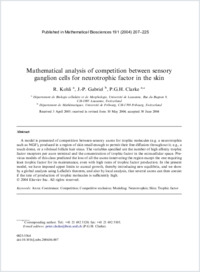Mathematical analysis of competition between sensory ganglion cells for neurotrophic factor in the skin
- Kohli, R. Department of Cell Biology and Morphology, Lausanne University, Switzerland
- Gabriel, Jean-Pierre Department of Mathematics, University of Fribourg, Switzerland
- Clarke, P. G. H. Department of Cell Biology and Morphology, Lausanne University, Switzerland
-
21.08.2004
Published in:
- Mathematical Biosciences. - 2004, vol. 191, no. 2, p. 207-225
English
A model is presented of competition between sensory axons for trophic molecules (e.g. a neurotrophin such as NGF), produced in a region of skin small enough to permit their free diffusion throughout it; e.g., a touch dome, or a vibrissal follicle hair sinus. The variables specified are the number of high affinity trophic factor receptors per axon terminal and the concentration of trophic factor in the extracellular space. Previous models of this class predicted the loss of all the axons innervating the region except the one requiring least trophic factor for its maintenance, even with high rates of trophic factor production. In the present model, we have imposed upper limits to axonal growth, thereby introducing new equilibria, and we show by a global analysis using LaSalle’s theorem, and also by local analysis, that several axons can then coexist if the rate of production of trophic molecules is sufficiently high.
- Faculty
- Faculté des sciences et de médecine
- Department
- Département de Mathématiques
- Language
-
- English
- Classification
- Mathematics
- License
-
License undefined
- Identifiers
-
- RERO DOC 4153
- DOI 10.1016/j.mbs.2004.06.007
- Persistent URL
- https://folia.unifr.ch/unifr/documents/299671
Statistics
Document views: 240
File downloads:
- Texte intégral: 292
